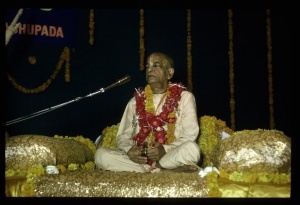CC Madhya 9.17: Difference between revisions
m (1 revision(s)) |
No edit summary |
||
| Line 1: | Line 1: | ||
{{ | [[Category:Sri Caitanya-caritamrta - Madhya-lila Chapter 09|C017]] | ||
<div style="float:left">'''[[Sri Caitanya-caritamrta|Śrī Caitanya-caritāmṛta]] - [[CC Madhya|Madhya-līlā]] - [[CC Madhya 9|Chapter 9: Lord Śrī Caitanya Mahāprabhu's Travels to the Holy Places]]'''</div> | |||
<div style="float:right">[[File:Go-previous.png|link=CC Madhya 9.16|Madhya-līlā 9.16]] '''[[CC Madhya 9.16|Madhya-līlā 9.16]] - [[CC Madhya 9.18|Madhya-līlā 9.18]]''' [[File:Go-next.png|link=CC Madhya 9.18|Madhya-līlā 9.18]]</div> | |||
{{CompareVersions|CC|Madhya 9.17|CC 1975|CC 1996}} | |||
{{RandomImage}} | |||
==== TEXT 17 ==== | ==== TEXT 17 ==== | ||
<div | <div class="verse"> | ||
nṛsiṁha dekhiyā tāṅre kaila nati-stuti | :nṛsiṁha dekhiyā tāṅre kaila nati-stuti | ||
siddhavaṭa gelā yāhāṅ mūrti sītāpati | :siddhavaṭa gelā yāhāṅ mūrti sītāpati | ||
</div> | </div> | ||
| Line 12: | Line 16: | ||
==== SYNONYMS ==== | ==== SYNONYMS ==== | ||
<div | <div class="synonyms"> | ||
nṛsiṁha | ''nṛsiṁha dekhiyā''—after seeing the Lord Nṛsiṁha Deity; ''tāṅre''—unto Him; ''kaila''—did; ''nati-stuti''—offering of various prayers; ''siddhavaṭa''—to Siddhavaṭa; ''gelā''—He went; ''yāhāṅ''—where; ''mūrti''—the Deity; ''sītā-pati''—Lord Rāmacandra. | ||
</div> | </div> | ||
| Line 19: | Line 23: | ||
==== TRANSLATION ==== | ==== TRANSLATION ==== | ||
<div | <div class="translation"> | ||
Upon seeing the Ahovala-nṛsiṁha Deity, Caitanya Mahāprabhu offered many prayers unto the Lord. He then went to Siddhavaṭa, where He saw the Deity of Rāmacandra, the Lord of Sītādevī. | Upon seeing the Ahovala-nṛsiṁha Deity, Caitanya Mahāprabhu offered many prayers unto the Lord. He then went to Siddhavaṭa, where He saw the Deity of Rāmacandra, the Lord of Sītādevī. | ||
</div> | </div> | ||
| Line 26: | Line 30: | ||
==== PURPORT ==== | ==== PURPORT ==== | ||
<div | <div class="purport"> | ||
Siddhavaṭa, also known as Sidhauṭa, is ten miles east of the village of Kuḍāpā. Previously this place was also known as the southern Benares. There is a great banyan tree there, and it is therefore known as Siddhavaṭa. Vaṭa means banyan tree. | Siddhavaṭa, also known as Sidhauṭa, is ten miles east of the village of Kuḍāpā. Previously this place was also known as the southern Benares. There is a great banyan tree there, and it is therefore known as Siddhavaṭa. ''Vaṭa'' means banyan tree. | ||
</div> | </div> | ||
__NOTOC__ | |||
<div style="float:right; clear:both;">[[File:Go-previous.png|link=CC Madhya 9.16|Madhya-līlā 9.16]] '''[[CC Madhya 9.16|Madhya-līlā 9.16]] - [[CC Madhya 9.18|Madhya-līlā 9.18]]''' [[File:Go-next.png|link=CC Madhya 9.18|Madhya-līlā 9.18]]</div> | |||
__NOTOC__ | |||
__NOEDITSECTION__ | |||
Revision as of 12:03, 22 August 2021
Śrī Caitanya-caritāmṛta - Madhya-līlā - Chapter 9: Lord Śrī Caitanya Mahāprabhu's Travels to the Holy Places

His Divine Grace
A.C. Bhaktivedanta Swami Prabhupada
A.C. Bhaktivedanta Swami Prabhupada
TEXT 17
- nṛsiṁha dekhiyā tāṅre kaila nati-stuti
- siddhavaṭa gelā yāhāṅ mūrti sītāpati
SYNONYMS
nṛsiṁha dekhiyā—after seeing the Lord Nṛsiṁha Deity; tāṅre—unto Him; kaila—did; nati-stuti—offering of various prayers; siddhavaṭa—to Siddhavaṭa; gelā—He went; yāhāṅ—where; mūrti—the Deity; sītā-pati—Lord Rāmacandra.
TRANSLATION
Upon seeing the Ahovala-nṛsiṁha Deity, Caitanya Mahāprabhu offered many prayers unto the Lord. He then went to Siddhavaṭa, where He saw the Deity of Rāmacandra, the Lord of Sītādevī.
PURPORT
Siddhavaṭa, also known as Sidhauṭa, is ten miles east of the village of Kuḍāpā. Previously this place was also known as the southern Benares. There is a great banyan tree there, and it is therefore known as Siddhavaṭa. Vaṭa means banyan tree.